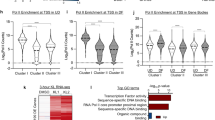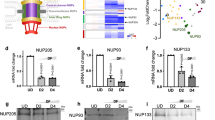Abstract
E2F factors modulate a plethora of cell functions, including proliferation, differentiation, DNA repair and apoptosis. We have shown that differentiation in primary epidermal keratinocytes leads to E2F1 downregulation via activation of protein kinase C and p38 mitogen-activated protein kinase. We now demonstrate that E2F1 downregulation in differentiating keratinocytes involves its ubiquitination, as well as proteasomal degradation subsequent to CRM1-dependent nuclear export. E2F1 nuclear export specifically in response to differentiation requires regions adjacent to the cyclin A-binding domain in the N-terminus of this protein. Significantly, inhibition of p38 interferes with nuclear export and degradation of E2F1 during differentiation, but has no effect on E2F1 in undifferentiated cells. Thus, induction of differentiation in epidermal keratinocytes activates a specific program for post-transcriptional downregulation of E2F1, which involves signaling through p38 and activation of nuclear export pathways.
This is a preview of subscription content, access via your institution
Access options
Subscribe to this journal
Receive 50 print issues and online access
$259.00 per year
only $5.18 per issue
Buy this article
- Purchase on Springer Link
- Instant access to full article PDF
Prices may be subject to local taxes which are calculated during checkout






Similar content being viewed by others
References
Apostolova MD, Ivanova IA, Dagnino C, D'Souza SJA, Dagnino L . (2002). Active import and export mechanisms regulate E2F-5 subcellular localization. J Biol Chem 277: 34471–34479.
Asher G, Shaul Y . (2005). p53 Proteasomal degradation. Cell Cycle 4: 1015–1018.
Byrne C, Hardman MJ, Nield K . (2003). Covering the limb – formation of the integument. J Anat 202: 113–124.
Campanero MR, Flemington EK . (1997). Regulation of E2F through ubiquitin–proteasome-dependent degradation: stabilization by the pRB tumor suppressor protein. Proc Natl Acad Sci USA 94: 2221–2226.
Chang WY, Bryce DM, D'Souza SJA, Dagnino L . (2004). The DP-1 transcription factor is required for keratinocyte growth and epidermal stratification. J Biol Chem 279: 51343–51353.
D'Souza SJA, Pajak A, Balazsi K, Dagnino L . (2001). Ca+2 and BMP-6 signalling regulate E2F during epidermal keratinocyte differentiation. J Biol Chem 276: 23531–23538.
D'Souza SJA, Vespa A, Murkherjee S, Maher A, Pajak S, Dagnino L . (2002). E2F-1 is essential for normal epidermal wound repair. J Biol Chem 277: 10626–10632.
Dagnino L, Fry CJ, Bartley SM, Farnham P, Gallie BL, Phillips RA . (1997a). Expression patterns of the E2F family of transcription factors during mouse nervous system development. Mech Dev 66: 13–25.
Dagnino L, Fry CJ, Bartley SM, Farnham P, Gallie BL, Phillips RA . (1997b). Expression patterns of the E2F family of transcription factors during murine epithelial development. Cell Growth Differ 8: 553–563.
Dicker AJ, Popa C, Dahler AL, Serewko MM, Hilditch-Maguire PA, Frazer IH et al. (2000). E2F-1 induces proliferation-specific genes and suppresses squamous differentiation-specific genes in human epidermal keratinocytes. Oncogene 19: 2887–2894.
Dlugosz AA, Glick AB, Tennenbaum T, Weinberg WC, Yuspa SH . (1995). Isolation and utilization of epidermal keratinocytes for oncogene research. Methods Enzymol 254: 3–20.
Efimova T, La Cell P, Welter JF, Eckert RL . (1998). Regulation of human involucrin promoter activity by a protein kinase C, Ras. MEKK1, MEK3 p38/RK, AP1 signal transduction pathway. J Biol Chem 38: 24387–24395.
Fajas L, Landsberg RL, Huss-Garcia Y, Sardet C, Lees JA, Auwerx J . (2002). E2Fs regulate adipocyte differentiation. Dev Cell 3: 39–49.
Freedman DA, Levine JA . (1998). Nuclear export is required for degradation of endogenous p53 by MDM2 and human papilloma virus E6. Mol Cell Biol 18: 7288–7293.
Gaubatz S, Lees JA, Lindeman GJ, Livingston DM . (2001). E2F4 is exported from the nucleus in a CRM1-dependent manner. Mol Cell Biol 21: 1384–1392.
Gill RM, Hamel PA . (2000). Subcellular compartmentalization of E2F family members is required for maintenance of the postmitotic state in terminally differentiated muscle. J Cell Biol 148: 1187–1201.
Gomez DA, Martinez-Martinez S, Maldonado JL, Ortega-Perez I, Redondo JM . (2000). A role for the p38 MAP kinase pathway in the nuclear shuttling of NFATp. J Biol Chem 275: 13872–13878.
Ito M, Liu Y, Yang Z, Nguyen J, Liang F, Morris RJ et al. (2005). Stem cells in the hair follicle bulge contribute to wound repair, but not to homeostasis of the epidermis. Nat Med 11: 1351–1354.
Ivanova IA, D'Souza SJA, Dagnino L . (2006). E2F stability is regulated by a novel-PKC/p38 MAP kinase signalling pathway during keratinocyte differentiation. Oncogene 25: 430–437.
Jones SJ, Dicker AJ, Dahler AL, Saunders NA . (1997). E2F as a regulator of keratinocyte proliferation: implications for skin tumor development. J Invest Dermatol 109: 187–193.
Marti A, Wirbelauer C, Scheffner M, Krek W . (1999). Interaction between ubiquitin–protein ligase SCFSKP2 and E2F-1 underlies the regulation of E2F-1 degradation. Nat Cell Biol 1: 14–19.
Muller H, Moroni MC, Vigo E, Petersen BO, Bartek J, Helin K . (1997). Induction of S-phase entry by E2F transcription factors depends on their nuclear localization. Mol Cell Biol 17: 5508–5520.
Ruiz S, Santos M, Paramio JM . (2006). Is the loss of pRb essential for the mouse skin carcinogenesis? Cell Cycle 5: 625–629.
Ruiz S, Santos M, Segrelles C, Leis H, Jorcano JL, Berns A et al. (2004). Unique and overlapping functions of pRb and p107 in the control of proliferation and differentiation in epidermis. Development 131: 2737–2748.
Vespa A, D'Souza SJA, Dagnino L . (2005). A novel role for integrin-linked kinase in epithelial sheet morphogenesis. Mol Biol Cell 16: 4084–4095.
Acknowledgements
We thank Drs M Tini and S D'Souza for helpful comments on the manuscript. This work was supported by grants to LD from the Natural Science and Engineering Research Council of Canada, and the National Cancer Institute of Canada (NCIC) with funds from the Canadian Cancer Society and the Terry Fox Foundation, raised through the Terry Fox Run. IAI holds research studentships from the Terry Fox Foundation, through an award from NCIC, and from the Canadian Institutes of Health Research Training Program in Cancer Research and Technology Transfer.
Author information
Authors and Affiliations
Corresponding author
Rights and permissions
About this article
Cite this article
Ivanova, I., Dagnino, L. Activation of p38- and CRM1-dependent nuclear export promotes E2F1 degradation during keratinocyte differentiation. Oncogene 26, 1147–1154 (2007). https://doi.org/10.1038/sj.onc.1209894
Received:
Revised:
Accepted:
Published:
Issue Date:
DOI: https://doi.org/10.1038/sj.onc.1209894
Keywords
This article is cited by
-
TLR3 activation induces S100A7 to regulate keratinocyte differentiation after skin injury
Science China Life Sciences (2017)
-
Looking beyond the Wnt pathway for the deep nature of β‐catenin
EMBO reports (2013)
-
Nucleocytoplasmic shuttling and CRM1-dependent MHC class I peptide presentation of human cytomegalovirus pp65
Medical Microbiology and Immunology (2012)
-
Identification of the Rage-dependent gene regulatory network in a mouse model of skin inflammation
BMC Genomics (2010)
-
Phosphorylation by p38 MAP kinase is required for E2F1 degradation and keratinocyte differentiation
Oncogene (2009)



